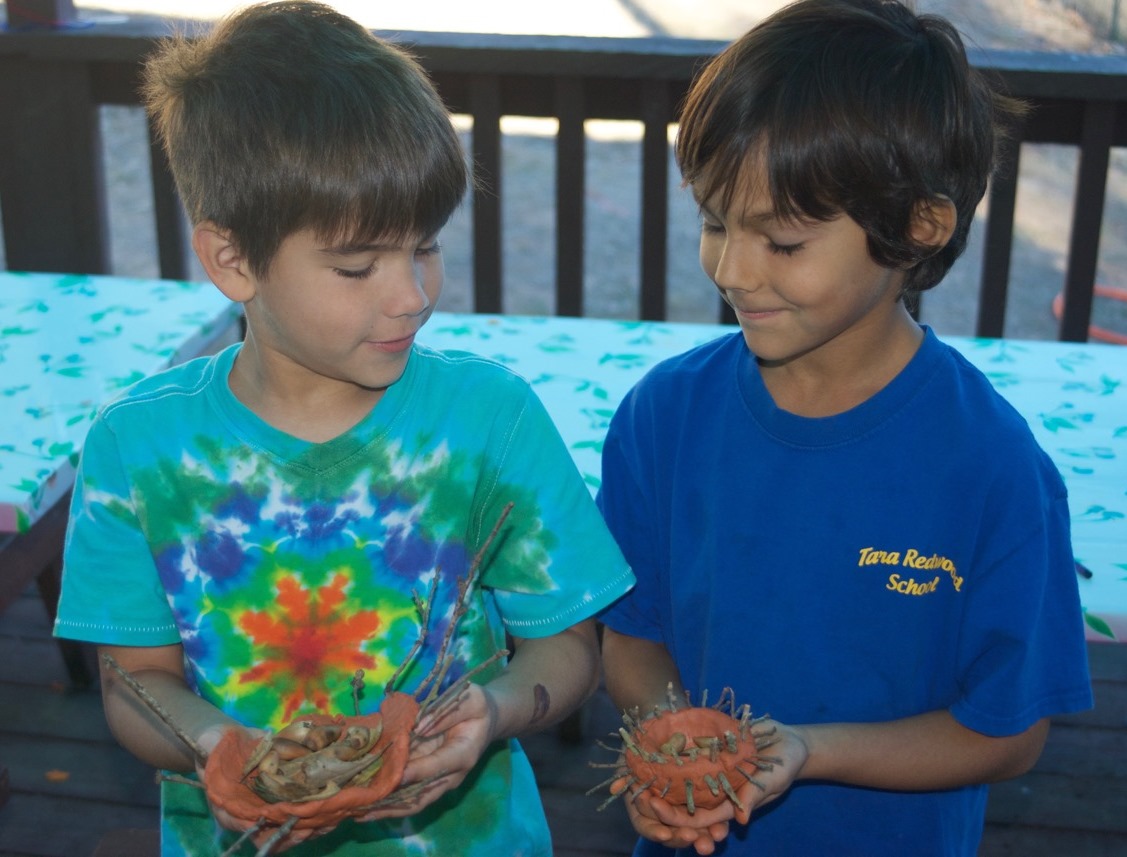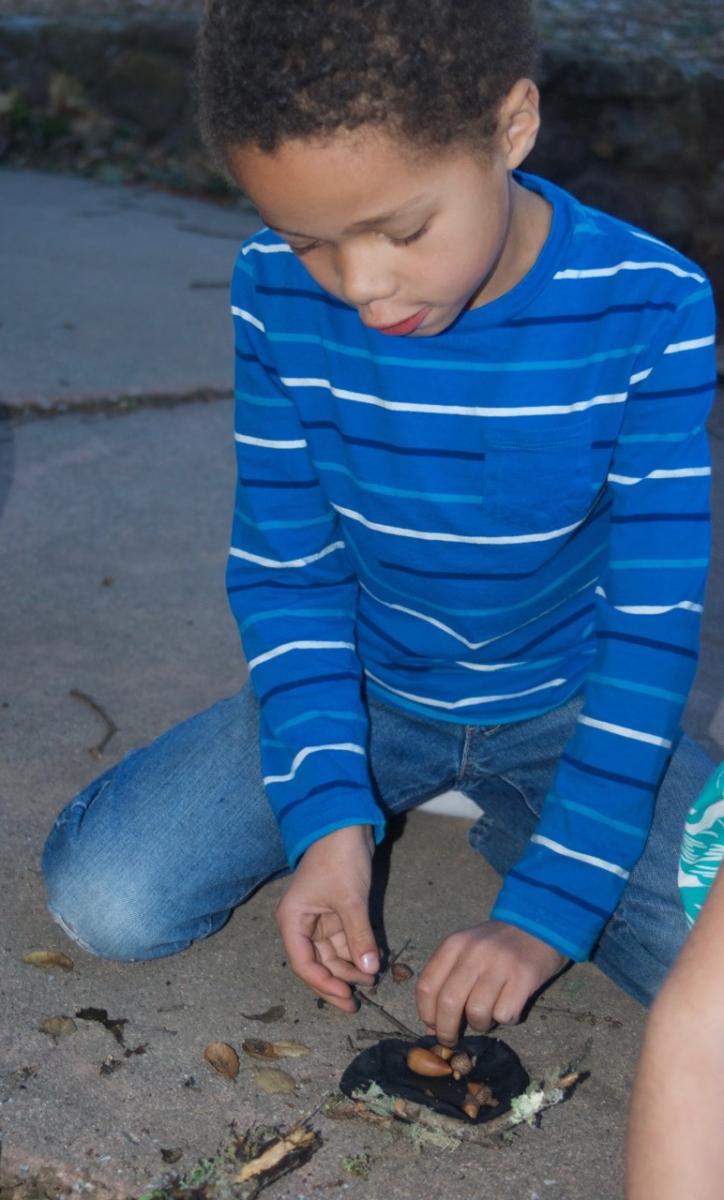 Like little birds building nests from materials gathered from the surrounding habitat, first and second graders eagerly collected small sticks, acorns, bits of grass and oak leaves to push into clay and dough that they’d fashioned into small, bowl-shaped-nests. This unique hands-on activity was just one piece of a cross-curricular bird study that included learning about identification and field marks, incubation, developmental stages, habitat and adaptations.
Like little birds building nests from materials gathered from the surrounding habitat, first and second graders eagerly collected small sticks, acorns, bits of grass and oak leaves to push into clay and dough that they’d fashioned into small, bowl-shaped-nests. This unique hands-on activity was just one piece of a cross-curricular bird study that included learning about identification and field marks, incubation, developmental stages, habitat and adaptations. ‘We learned what makes a bird a bird,’ said second grade student Eduardo Loving, ‘and how birds are different from other animals, like amphibians or reptiles and how they are alike.’
 Students studied bird identification with the help of a colored-code resource book, Stokes Beginner’s Guide to Birds: Western Region . They discussed the various parts of a bird, coloring in each section on printed sheets as teacher Cassia Laffin gave instructions such as ‘color the nape of the bird’s neck’ or ‘color the crest of your bird’s head.’ This activity helped to prepare them when it came to identifying ‘field marks’ — physical traits that unique to a particular bird, such as size or shape of beak or color of feather — and provided students with a more specialized vocabulary for describing the attributes of different birds. Their teacher hung an array of bird pictures around the classroom and outdoors, which the students examined before selecting several to draw and identify.
Students studied bird identification with the help of a colored-code resource book, Stokes Beginner’s Guide to Birds: Western Region . They discussed the various parts of a bird, coloring in each section on printed sheets as teacher Cassia Laffin gave instructions such as ‘color the nape of the bird’s neck’ or ‘color the crest of your bird’s head.’ This activity helped to prepare them when it came to identifying ‘field marks’ — physical traits that unique to a particular bird, such as size or shape of beak or color of feather — and provided students with a more specialized vocabulary for describing the attributes of different birds. Their teacher hung an array of bird pictures around the classroom and outdoors, which the students examined before selecting several to draw and identify.‘We looked at and identified bones in the human body and then compared and contrasted to the bones in birds’ bodies,’ shared Laffin. ‘We found that structurally there are many similarities. Students were very engaged. They worked collaboratively and practiced turn-taking by sharing books. The art component was well-received and I was impressed by some of the really detailed drawings students made.’

The class attempted to incubate bantam chicken eggs and kept ‘chicken journals,’ writing about and drawing the ways in which the embryos were changing (visible when they candled the eggs). Although the eggs didn’t hatch, Laffin said they are planning to try again later in the year.
‘If we do hatch baby chicks,’ said second grader Colby Saunders, ‘they are going to come home to live with me. My parents said it is okay.’
Each student chose a bird to research and give a presentation on to their classmates. Students enjoyed learning from each other, and most chose birds native to the area, including Peregrine Falcons, American Bald Eagles, Great Horned Owls and American Crows, but not all. Other birds students learned about included swans, loons and lovebirds. Together the class sang bird songs, like ‘Rockin’ Robin,’ which included a reading lesson as students followed along to the written lyrics; and read bird books, both fiction and non-fiction. Laffin even brought her lovebird, ‘Co-co-mo’ for a visit.
 First grader Leo Francke presented on Great Horned Owls, while his classmate, Cassiano Konig reported on Peregrine Falcons.
First grader Leo Francke presented on Great Horned Owls, while his classmate, Cassiano Konig reported on Peregrine Falcons. ‘Great Horned Owls can eat Peregrine Falcons,’ shared first grader Leo Francke. ‘That’s what Cassiano said were its predators.’
‘I liked learning that crows in Japan drop nuts under the wheels of cars,’ said first grader MaaNgala Mapaka, ‘so that when the cars go, they crack the shells, because the crows cannot do it themselves.’

The ‘outdoor classroom’ was a great resource for their study, too: wild turkeys, for example, are visible and numerous on the property surrounding the School campus, and the students also spent a little extra time learning about these birds and how to differentiate between males and females as well as some behavior characteristics.
A popular activity amidst this in-depth study was shared with the students’ sophomore buddies, with the group dissecting owl pellets. Laffin said her young students were surprised to learn that the pellets were actually regurgitated contents that the bird could not digest.
Most students enjoyed the ‘discoveries’ in the pellets, including a couple tiny skulls and numerous bones. Students were challenged to determine what the owls had eaten by looking at the size and shape of the bones they found. They kept tally sheets of each pelvic, rib, jaw or other bones they found.
First grader Kenzie Culbertson was so excited by the activity, that she brought her mom and sister into the classroom after school to see the contents of the pellets she’d dissected!

Students learned about the owl’s unique eyesight and also about their own eyes and vision. One student’s grandfather, a retired eye doctor, will soon be visiting the class to share more about vision.
‘The children were fascinated by realizing how our pupils change according to the amount of light,’ shared Laffin. ‘We had all kinds of great discussions and ‘ah-ha’ moments, such as how our eyes adjust to the dark and why eyes are so sensitive to light when a person first wakes up.
‘Students are so engaged when units of study are in-depth and cross-curricular,’ explained Laffin. ‘I like offering lessons that combine writing, language skills, science, art and music where students can choose to work collaboratively or independently, and also take turns being the ‘teacher’ and presenting to their peers. In these types of projects, the learning is exponential.’
Photos by Cassia Laffin
Contact: Leigh Ann Clifton, Director of Marketing & Comunications,
Nestled among the redwoods on 355 acres, Mount Madonna School (MMS) is a community of learners dedicated to creative, intellectual, and ethical growth. MMS supports its students in becoming caring, self-aware, discerning and articulate individuals; and believe a fulfilling life includes personal accomplishments, meaningful relationships and service to society. The CAIS and WASC accredited program emphasizes academic excellence, creative self-expression and positive character development. Located on Summit Road between Gilroy and Watsonville.
